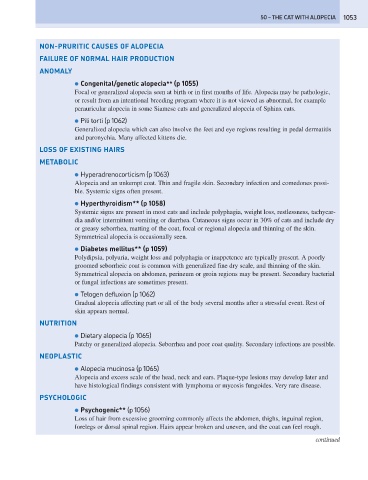Page 1061 - Problem-Based Feline Medicine
P. 1061
50 – THE CAT WITH ALOPECIA 1053
NON-PRURITIC CAUSES OF ALOPECIA
FAILURE OF NORMAL HAIR PRODUCTION
ANOMALY
● Congenital/genetic alopecia** (p 1055)
Focal or generalized alopecia seen at birth or in first months of life. Alopecia may be pathologic,
or result from an intentional breeding program where it is not viewed as abnormal, for example
perauricular alopecia in some Siamese cats and generalized alopecia of Sphinx cats.
● Pili torti (p 1062)
Generalized alopecia which can also involve the feet and eye regions resulting in pedal dermatitis
and paronychia. Many affected kittens die.
LOSS OF EXISTING HAIRS
METABOLIC
● Hyperadrenocorticism (p 1063)
Alopecia and an unkempt coat. Thin and fragile skin. Secondary infection and comedones possi-
ble. Systemic signs often present.
● Hyperthyroidism** (p 1058)
Systemic signs are present in most cats and include polyphagia, weight loss, restlessness, tachycar-
dia and/or intermittent vomiting or diarrhea. Cutaneous signs occur in 30% of cats and include dry
or greasy seborrhea, matting of the coat, focal or regional alopecia and thinning of the skin.
Symmetrical alopecia is occasionally seen.
● Diabetes mellitus** (p 1059)
Polydipsia, polyuria, weight loss and polyphagia or inappetence are typically present. A poorly
groomed seborrheic coat is common with generalized fine dry scale, and thinning of the skin.
Symmetrical alopecia on abdomen, perineum or groin regions may be present. Secondary bacterial
or fungal infections are sometimes present.
● Telogen defluxion (p 1062)
Gradual alopecia affecting part or all of the body several months after a stressful event. Rest of
skin appears normal.
NUTRITION
● Dietary alopecia (p 1065)
Patchy or generalized alopecia. Seborrhea and poor coat quality. Secondary infections are possible.
NEOPLASTIC
● Alopecia mucinosa (p 1065)
Alopecia and excess scale of the head, neck and ears. Plaque-type lesions may develop later and
have histological findings consistent with lymphoma or mycosis fungoides. Very rare disease.
PSYCHOLOGIC
● Psychogenic** (p 1056)
Loss of hair from excessive grooming commonly affects the abdomen, thighs, inguinal region,
forelegs or dorsal spinal region. Hairs appear broken and uneven, and the coat can feel rough.
continued

